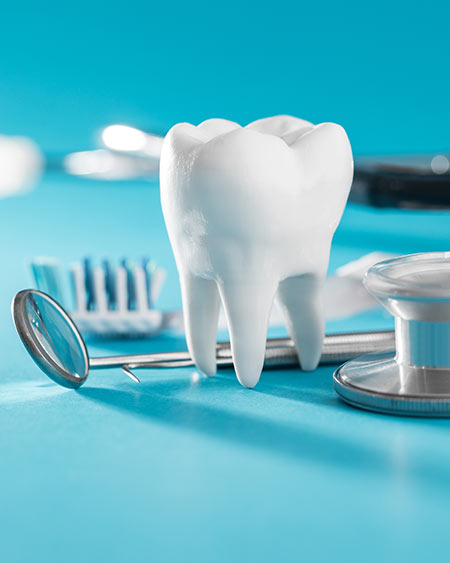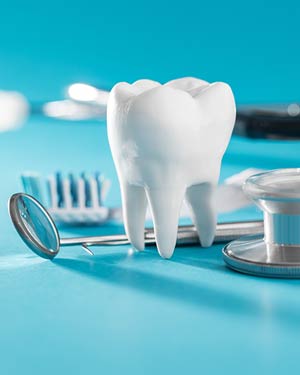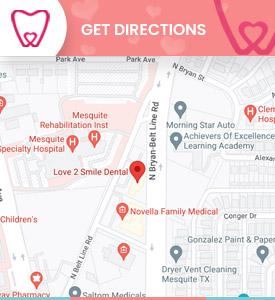Can a Dentist Fix a Loose Tooth?
Dr. Divya Nagaraj, DDS, at Love 2 Smile Dental Practice, carefully assesses your loose tooth, pinpoints the underlying cause, and devises a tailored treatment plan. This may involve stabilizing the tooth with a splint, repairing internal damage with root canal therapy, or, in severe cases, extracting the tooth and replacing it with a dental implant or bridge. Connect with us with any questions you may have or, when ready, you can schedule an appointment online at your earliest convenience. We are located at 1050 N Bryan-Belt Line Rd Ste 102, Mesquite, TX 75149.


When a tooth becomes loose, it can be a cause for concern and discomfort. However, the good news is that dentists can often fix a loose tooth and restore stability to your smile. Understanding the causes of a loose tooth and the available treatment options can help you take the necessary steps to address the issue promptly.
Understanding the Causes of a Loose Tooth
A loose tooth can result from various factors, ranging from gum disease to injuries and even underlying health conditions such as osteoporosis. Identifying the specific cause is crucial in determining the most effective treatment approach. When it comes to dental health, understanding the causes of a loose tooth is essential for maintaining a healthy smile. Let’s delve deeper into the different factors that can contribute to tooth looseness and explore the treatments available for each condition.
Gum Disease and Loose Teeth
Gum disease, also known as periodontal disease, is a common cause of loose teeth. When plaque builds up along the gumline, it can lead to infection and inflammation, causing the gums to pull away from the teeth. This can result in the loss of supporting bone and ultimately looseness in the affected tooth.
Preventing and treating gum disease is vital for maintaining healthy teeth and gums. Regular dental check-ups and proper oral hygiene practices, such as brushing and flossing, can help prevent plaque buildup and reduce the risk of gum disease. To treat gum disease and address loose teeth caused by this condition, dentists may recommend deep cleaning procedures. These treatments involve removing plaque and tartar buildup below the gum line and promoting gum tissue healing to help stabilize the affected tooth. In severe cases, surgical interventions may be necessary to restore gum health and prevent further tooth mobility.
Injury-Induced Loose Teeth
Injuries to the mouth, such as a blow or accident, can lead to loose teeth. The impact can damage the ligaments and tissues that hold the tooth in place. Prompt evaluation and treatment by a dentist are essential to prevent further complications. If a loose tooth is a result of an injury, dentists may suggest conservative methods to stabilize it. These can include tooth splinting, which involves bonding the loose tooth to the neighboring teeth to promote stability during the healing process.
In more severe cases, root canal therapy or tooth extraction may be necessary to ensure overall oral health and prevent infection. It’s important to note that even if a loose tooth is not causing immediate pain or discomfort, seeking professional dental care is crucial. Untreated injuries can lead to long-term complications and affect the overall functionality of the affected tooth.
Osteoporosis and Tooth Looseness
People with osteoporosis, a condition characterized by weakened bones, are at an increased risk of experiencing loose teeth. The weakened jawbone can compromise the stability of the teeth, leading to mobility. Managing osteoporosis is crucial for maintaining overall health, and it can also help prevent tooth looseness. A well-balanced diet rich in calcium and vitamin D, regular exercise, and appropriate medications prescribed by healthcare professionals can help slow down bone loss and improve bone density. When treating loose teeth due to osteoporosis, dentists may recommend non-surgical and surgical approaches. Non-surgical treatments typically aim to manage the symptoms and prevent further progression of bone loss. These can include dental splints or mouthguards to provide support and stability to the affected teeth. In severe cases, surgical interventions such as bone grafting or dental implants may be necessary to restore the functionality and aesthetics of the oral cavity. In conclusion, understanding the causes of a loose tooth is essential for determining the appropriate treatment approach. Whether it’s gum disease, injuries, or underlying health conditions like osteoporosis, seeking professional dental care is crucial for maintaining a healthy smile and overall oral health.
The Role of Dentists in Treating Loose Teeth
When dealing with a loose tooth, seeking professional dental care is crucial. Dentists possess the expertise and tools necessary to diagnose the cause accurately and develop an individualized treatment plan. Let’s explore some of the key aspects of their role in treating loose teeth.
Initial Examination and Diagnosis
During your initial visit, the dentist will conduct a thorough examination of your oral health. This includes assessing the mobility of the affected tooth, evaluating the surrounding tissues, and reviewing your dental history. The dentist may also recommend additional tests, such as dental X-rays or periodontal assessments, to gather more information about the condition of your tooth and the supporting structures.
During the examination, the dentist will carefully inspect the tooth to determine the extent of the mobility. They will check for any signs of gum disease, tooth decay, or trauma that may have caused the tooth to become loose. By examining the surrounding tissues, the dentist can assess the overall health of your gums and jawbone, which play a crucial role in supporting the teeth. In some cases, the dentist may also perform a bite analysis to evaluate how your teeth come together when you bite down. This analysis can help identify any issues with your bite that may be contributing to the loose tooth.
Treatment Options for Loose Teeth
Based on the diagnosis, the dentist will present different treatment options tailored to your specific situation. The treatment plan may involve non-surgical or surgical interventions, depending on tooth mobility’s underlying cause and severity. If gum disease is the primary cause of the loose tooth, the dentist may recommend a deep cleaning procedure called scaling and root planing. This treatment involves removing plaque and tartar from the tooth and root surfaces, as well as smoothing out any rough areas to promote gum reattachment. When tooth mobility is due to trauma or injury, the dentist may suggest splinting the loose tooth to stabilize it.
Splinting involves bonding the loose tooth to the adjacent teeth to provide support and allow for the healing process to take place. For more severe cases, surgical interventions may be necessary. This can include procedures such as bone grafting, where bone or bone-like materials are added to the jawbone to strengthen it, or tooth extraction followed by a dental implant or bridge placement. Throughout the treatment process, the dentist will closely monitor the progress of your loose tooth. They will guide oral hygiene practices, including proper brushing and flossing techniques, to maintain good oral health and prevent further complications.
It’s important to note that the success of the treatment for a loose tooth depends on various factors, including the underlying cause, the patient’s overall oral health, and their commitment to follow the dentist’s recommendations. In conclusion, dentists play a crucial role in treating loose teeth. Through their expertise and comprehensive examination, they can accurately diagnose the cause of tooth mobility and develop an appropriate treatment plan. Whether through non-surgical interventions or surgical procedures, dentists aim to restore the stability and function of the affected tooth, ultimately improving the patient’s oral health and quality of life.
Non-Surgical Treatments for Loose Teeth
Non-surgical treatments are often the first line of defense in addressing loose teeth. These interventions focus on addressing the underlying causes and promoting oral health to prevent further tooth mobility. When it comes to loose teeth, there are various non-surgical treatment options available that can help restore stability and enhance oral health.
Let’s explore some of these treatments in detail:
Deep Cleaning Procedures
Deep cleaning procedures, such as scaling and root planing, are frequently recommended for loose teeth caused by gum disease. These treatments involve removing plaque and tartar from below the gum line, effectively reducing inflammation and promoting gum tissue healing. During scaling, the dentist or dental hygienist uses special instruments to remove the built-up plaque and tartar from the tooth surfaces and beneath the gum line. This thorough cleaning helps eliminate the bacteria that contribute to gum disease and tooth mobility.
Root planing, on the other hand, involves smoothing out the rough surfaces of the tooth roots to prevent bacteria from reattaching and causing further damage. This procedure encourages the gums to reattach to the tooth, promoting stability and preventing tooth loss. Regular dental cleanings and maintenance visits may also be part of the treatment plan to monitor the condition of the tooth and ensure optimal oral hygiene. These visits provide an opportunity for the dentist to assess the progress of the treatment and make any necessary adjustments.
Medications and Antibiotics
In some cases, dentists may prescribe medications or antibiotics to manage infections and reduce inflammation associated with loose teeth. These medications can aid in the healing process and promote tissue stability. Antibiotics are often prescribed to combat bacterial infections that may be contributing to tooth mobility. They can help eliminate harmful bacteria and prevent the spread of infection, allowing the gums to heal and the tooth to regain stability. Additionally, certain medications may be recommended to address underlying conditions that may be contributing to loose teeth, such as osteoporosis or hormonal imbalances. By treating these conditions, overall oral health can be improved, reducing the risk of further tooth mobility.
Bite Adjustment Malocclusion
Bite Adjustment Malocclusion or an improper bite, can contribute to tooth mobility. Dentists may recommend biting adjustment procedures to correct the alignment of your teeth and reduce strain on the loose tooth. During a bite adjustment procedure, the dentist carefully evaluates the alignment of your teeth and makes necessary adjustments to ensure proper occlusion. This can involve reshaping the biting surfaces of the teeth, using orthodontic appliances, or even recommending orthognathic surgery in severe cases. By correcting the bite, the pressure and force exerted on the loose tooth can be distributed more evenly among the teeth, reducing the risk of further mobility and promoting stability. It’s important to note that the success of non-surgical treatments for loose teeth depends on various factors, including the underlying cause, the severity of the condition, and the patient’s overall oral health. It’s crucial to consult with a qualified dentist who can assess your specific situation and recommend the most appropriate treatment plan to restore stability and maintain optimal oral health.
Surgical Treatments for Loose Teeth
Surgical interventions may be necessary for severe cases of loose teeth or when non-surgical approaches have not yielded satisfactory results. Let’s explore some of the surgical treatments dentists may consider.
Bone Grafts
In cases where bone loss has significantly affected the stability of the tooth, dentists may recommend bone grafts. This procedure involves transplanting bone tissue to the affected area to support the loose tooth and encourage bone regeneration.
Soft Tissue Grafts
Soft tissue grafts can be used to address loose teeth resulting from receding gums. During this procedure, gum tissue from another area of your mouth is transplanted to the affected site, providing support and protection for the tooth root.
Tooth Splinting
Tooth splinting, as mentioned earlier, is a technique that involves bonding the loose tooth to adjacent stable teeth. This method provides stability and support while the ligaments and tissues around the tooth heal. In conclusion, while a loose tooth can be a cause for concern, dentists have various treatment options at their disposal to help fix the issue. From non-surgical interventions like deep cleaning procedures and medications to surgical approaches like bone grafts and tooth splinting, dentists can tailor the treatment plan to address the underlying cause and restore stability to your smile. By seeking timely professional dental care, you can take the necessary steps to fix a loose tooth and maintain optimal oral health. Contact us today with any questions that you may have or, when ready, you can book online to schedule an appointment. We are located at 1050 N Bryan-Belt Line Rd Ste 102, Mesquite, TX 75149. We serve clients from Mesquite Dallas TX, Sunnyvale TX, Forney TX, Balch Springs TX, Garland TX, Seagoville TX, Rowlett TX, and Surrounding areas.


Additional Services You May Like
▸ Emergency Care
▸ Smile Makeover
▸ Invisalign
▸ General Dentistry
▸ Dentures
▸ Root Canal
▸ Dental Fillings
▸ Teeth Whitening
▸ Oral Cancer Screening
▸ Tooth Extraction
▸ Dental Crown
▸ Dental Bridges
▸ Dental Check-ups & Cleaning
▸ Pediatric Dentist
▸ Cosmetic Dentistry
▸ All-on-4 Dental Implants
▸ Dental Implants
▸ Single Tooth Implants



